Triangles Class 10 Ex 6.3
Q. 1. State which pairs of triangles in the given figures are similar. Write the similarity criterion used by you for answering the question and also write the pairs of similar triangles in the symbolic form :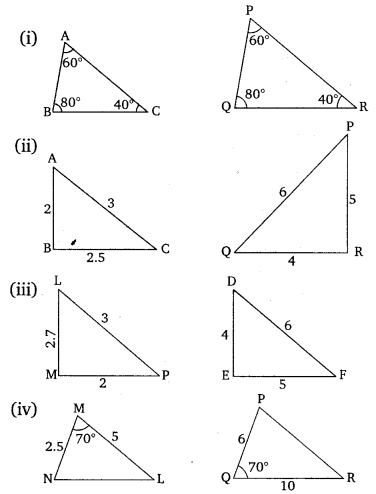
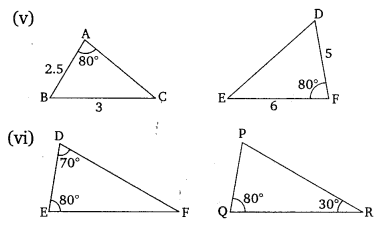
Solution:
Proofing:
As we know if in two triangles, corresponding angles are equal, then their corresponding sides are in the same ratio (or proportion) and hence the two triangles are similar.
This is referred as (Angle–Angle–Angle) criterion of similarity of two triangles.
Steps:
In and
All the corresponding angles of the triangles are equal.
By criterion
(ii)
As we know if in two triangles, side of one triangle are proportional to (i.e., in the same ratio ) the sides of the other triangle, then their corresponding angles are equal and hence the two triangles are similar.
This is referred as (Side–Side–Side) similarity criterion for two triangles.
Steps:
InΔABCandΔQRP
All the corresponding sides of two triangle are in same proportion.
By criterion
(iii)
As we know if in two triangles, side of one triangle are proportional to (i.e., in the same ratio ) the sides of the other triangle, then their corresponding angles are equal and hence the two triangles are similar.
This is referred as (Side–Side–Side) similarity criterion for two triangles.
Steps:
In and
All the corresponding sides of the two triangles are not in the same proportion.
Hence triangles are not similar.
(iv)
Proofing:
As we know if one angle of a triangle is equal to one angle of the other triangle and the sides including these angles are proportional, then the two triangles are similar.
This criterion is referred to as the (Side–Angle–Side) similarity criterion for two triangles.
Steps:
In and
One angle of a triangle is equal to one angle of the other triangle and the sides including these angles are proportional.
By criterion ⇒ΔNML∼ΔPQR
(v)
Proofing:As we know if one angle of a triangle is equal to one angle of the other triangle and the sides including these angles are proportional, then the two triangles are similar.
This criterion is referred to as the (Side–Angle–Side) similarity criterion for two triangles.
Steps:
In and
But must be equal to 80°
∵ The sides includes , not
Therefore, criterion is not satisfied
Hence,the triangles are not similar,
(vi)
As we are ware if two angles of one triangle are respectively equal to two angles of another triangle, then the two triangles are similar.
This may be referred to as the criterion for two triangles.
Steps:
In
∠D = 70°; ∠E = 80°
Sum of the angles in a triangle is
Now ,In ΔDEF and ΔPQR
Pair of corresponding angles of the triangles are equal.
By criterion ΔDEF∼ΔPQR
Q. 2. In the given figure, ∆ODC ~ ∆OBA, ∠BOC = 125° and ∠CDO = 70°. Find ∠DOC, ∠DCO and ∠OAB.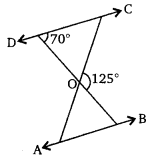
Solution:
Given:
∠COB=125°
∠CDO= 70°
In the given figure.
∠DOC + ∠COB =180° [by Linear pair]
In
In and
Q. 3. Diagonals AC and BD of a trapezium ABCD with AB || DC intersect each other at the point O. Using a similarity criterion for two triangles, show that
Solution:
Given: A trapezium ABCD in which diagonals AC and BD intersect at O.
AD||BC
To Prove:
OA/OC = OB/OD
Proof:
In
Hence
Second Method
Given: A trapezium ABCD in which diagonals AC and BD intersect at O.
AD||BC
To Prove:
OA/OC = OB/OD
Construction :
OE||AB||CD
Proof:
In
In
OE||CD
AE/ED=OA/OC .......(1)
Hence
Q. 4. In the given figure, 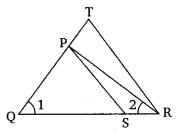
Solution:
In
(sides opposite to equal angles are equal)
In and
Hence Proved
Q 5. S and T are points on sides PR and QR of ∆PQR such that ∠P = ∠RTS. Show that ∆RPQ ~ ∆RTS.
Solution:
In ΔRPQ and ΔRTS
Q 6. In the given figure, if ∆ABE ≅ ∆ACD, show that ∆ADE ~ ∆ABC.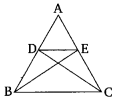
Solution:
In ΔABE and ΔACD
[by CPCT].....(2)
Now In ΔADE, ΔABC ,
AD/AB = AE/ AC. …from (1) & (2)
and
∠DAF = ∠BAC (Common angle)
⇒ΔADE∼ ΔABC (SAS criterion)
Q. 7. In the given figure, altitudes AD and CE of ∆ABC intersect each other at the point P. Show that:
(i) ∆AEP ~ ∆CDP
(ii) ∆ABD ~ ∆CBE
(iii) ∆AEP ~ ∆ADB
(iv) ∆PDC ~ ∆BEC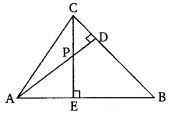
Solution:
(i)
Given:
AD and CE are altitudes of ΔABC
To Prove:
ΔAEP ∼ ΔCDP
Proof:
In and
(ii)
In ΔABD and ΔCBE
(iii)
In and
Q. 8. E is a point on the side AD produced of a parallelogram ABCD and BE intersects CD at F. Show that ∆ABE ~ ∆CFB.
Solution:
and in ΔABE, ΔCFB
∠BAE = ∠FCB
(opposite angles of a parallelogram)
∠AEB = ∠FBC
[∵AE||BC and EB is a transversal alternate angle]
⇒ΔABE∼ΔCFE (AA Criterion)
Q. 9. In the given figure, ABC and AMP are two right triangles, right angled at B and M respectively. Prove that:
(i)
(ii)
Solution:
(i) In and
In
∼
Ratio of the corresponding sides of similar triangles.
Ex 6.3 Class 10 Maths Question 10.
CD and GH are respectively the bisectors of ∠ACB and ∠EGF such that D and H lie on sides AB and FE of ∆ABC and ∆EFG respectively. If ∆ABC ~ ∆FEG, show that:
(i)
(ii)
(iii)
Solution:
(i)
Proofing:
In ΔABC and ΔFEG
∠C = ∠G
⇒∠ACD=∠FGH
( and are bisectors of respectively)
In and
If two triangles are similar, then their corresponding sides are in the same ratio.
(ii) Proofing:
In and
(iii)
In ΔDCA, ΔHGF
Q. 11. In the given figure, E is a point on side CB produced of an isosceles triangle ABC with AB = AC. If AD ⊥ BC and EF ⊥ AC, prove that ∆ABD ~ ∆ECF.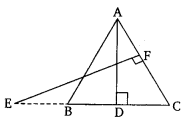
Solution:
Given: ΔABC is isosceles Δ in which AB=AC
⇒∠ABC=∠ACB (angle opposite to equal sides are equal)
In ΔABD,ΔECF
Q. 12. Sides AB and BC and median AD of a triangle ABC are respectively proportional to sides PQ and QR and median PM of ∆PQR (see in given figure). Show that ∆ABC ~ ∆PQR.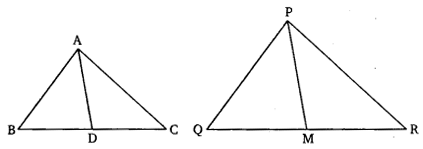
Solution:
Proofing:
In and
]
∵ AD and PM are median of and respectively
Now In ΔABD and ΔPQM
Now in ΔABC and ΔPQR
Q.13. D is a point on the side BC of a triangle ABC, such that ∠ADC = ∠BAC. Show that CA² = CB.CD.
Solution:
∠BAC = ∠ADC
(Given in the statement)
∠ACB=∠ACD (Common angles)
⇒ΔABC∼ΔDAC (AA criterion)
If two triangles are similar,then their corresponding sides are proportional
⇒CA/CD=CB/CA
⇒CA²=CB⋅CD
Q. 14. Sides AB and AC and median AD of a triangle ABC are respectively proportional to sides PQ and PR and median PM of another triangle PQR. Show that ∆ABC ~ ∆PQR.
Solution:
Produce to so that Join Similarly, produce to such that , and Join .
In and
Also, in and
Now,
Therefore,
Similarly,
Therefore,
Now, in ΔABC and ΔPQR
Q. 15. A vertical pole of length 6 m casts a shadow 4 m long on the ground and at the same time a tower casts a shadow 28 m long. Find the height of the tower.
Solution:
is the pole 6
is the shadow of pole 4
is the tower
is the shadow of the tower 28
In and
The ratio of any two corresponding sides in two equiangular triangles is always the same.
Q.16. If AD and PM are medians of triangles ABC and PQR respectively, where ∆ABC ~ ∆PQR. Prove that
Solution:
Proofing:
In
∠ABD=∠PQM …(from 1)
AB/PQ=BD/QM…(from 2)
⇒AB/PQ=BD/QM=AD/PM
(Corresponding sides)





















Post a Comment
Post a Comment